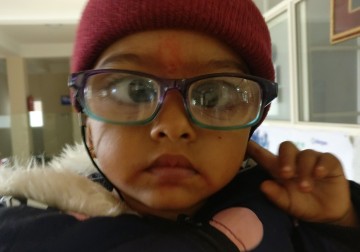In a new study from LVPEI, Drs. Virender Sachdeva and others describe co-existing pathologies that become underlying causes of poor visual acuity in patients with amblyopia. Such conditions are rarely diagnosed, leading to sub-optimal outcomes for children with amblyopia.
In Amblyopia (lazy eye), a child develops crossed eyes where the affected eye(s) drift outward or inward. Amblyopia typically manifests in children, between birth and 6-8 years of age. This age is a critical period in the development of the visual system. Any defect in the delivery of sensory information from an eye causes a breakdown in the brain-eye connection. This makes the brain reliant on the healthy eye, while vision in the affected eye becomes impaired. Such an impairment manifests as a decrease in visual acuity and other functions in the amblyopic eye. Failure to act early can lead to permanent vision impairment for the child, along with the social stigma of crossed eyes.
Catching amblyopia early can help fix the impairment and address the social stigma—however, this intent may also lead to its over-diagnosis. Conditions such as mild damage to the optic nerve (optic neuropathy) or occult macular dystrophy (OMD), an inherited retinal degeneration disorder, can also reduce visual acuity. But their diagnosis or co-existence may be masked under the more distinct symptoms of amblyopia. Amblyopia treatment usually takes months, even years. So, a misdiagnosis can push a patient down an ineffective treatment pathway for a significant period. It is entirely likely that a rare, underlying condition is never found, or is found too late. There are limited prior studies that look at the rate of amblyopia over-diagnosis. So, little is known about the steps to include in an amblyopia practice so that such rare conditions are not missed during an eye exam.
In a new, retrospective study published in the journal Strabismus, Drs. Virender Sachdeva and others from LVPEI report on the factors contributing to the over-diagnosis of amblyopia. The study included the electronic medical records of 508 children, aged 4-15 years, who were diagnosed with amblyopia over a 4-year period. Among them, 466 (92%) patients were diagnosed with amblyopia alone, while 26 (5%) children were found to have co-existing pathologies after an alternate diagnosis. These 26 children included patients who were referred to LVPEI after an initial diagnosis of amblyopia and amblyopia patients who showed no improvement in visual acuity even 6 months after treatment.
The study found that half of the 26 children were re-diagnosed with subclinical optic neuritis, an inflammation of the optic nerve. Ten children (38.4%) were re-diagnosed with OMD. Together, the two disorders formed the primary co-existing etiologies of misdiagnosed amblyopia. Children with ametropic amblyopia (31%)—where both eyes have impaired vision—were more likely to be misdiagnosed than other types of lazy eye. Anisometropia (46% cases), where each eye has a different refractive power; high refractive error; or a perceptible squint (heterotropia) (27%); and previous pediatric cataract surgery (15%) were the biggest risk factors for misdiagnosis. The study emphasizes that all amblyopia patients with an optic disc pallor, lower color perception, a history of parental consanguinity, and no improvement in visual acuity after treatment should be re-diagnosed for alternate etiologies.
‘One out of 20 children initially diagnosed with amblyopia might have a co-existing pathology,’ says Dr. Virender Sachdeva, pediatric ophthalmologist at LVPEI’s Nimmagadda Prasad Children’s Eye Care Centre, and the corresponding author of this paper. ‘These underlying conditions include subclinical optic neuropathy and occult macular dystrophy, which are difficult to diagnose and might cause suboptimal vision recovery.’
Citation
Sachdeva, V., Bhattacharya, B., Ganatra, S., & Kekunnaya, R. (2024). Subnormal visual acuity after compliant amblyopia therapy: residual/refractory amblyopia or co-existing pathology? - a retrospective analysis. Strabismus, 1–12. Advance online publication. https://doi.org/10.1080/09273972.2023.2294997
Photo credit: A child with thick glasses; by Rabindea Adhikary, WSD Photo competition 2019.



